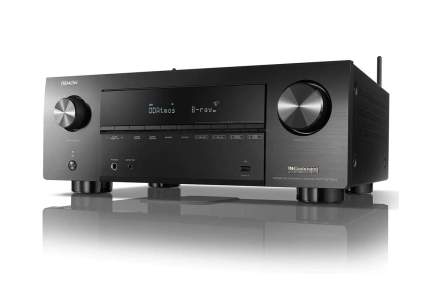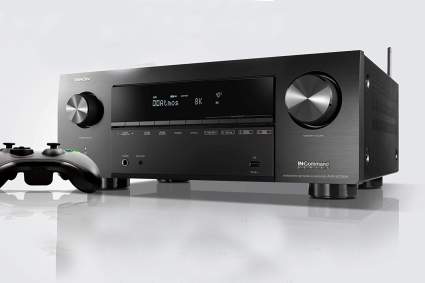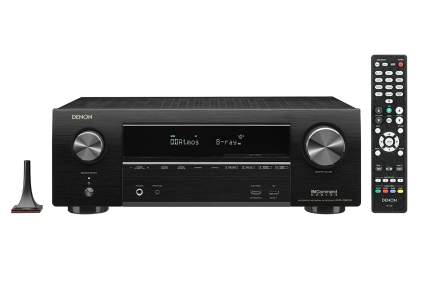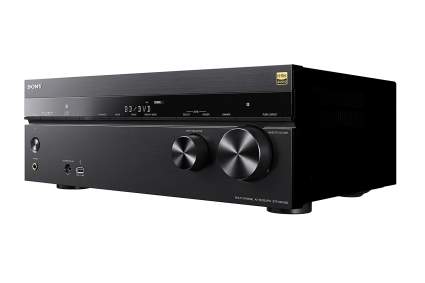
Denon The right home theater receiever can greatly improve your Friday night home movie experience.
A home theater receiver — or, more accurately, an AV receiver — is like a central switching station for all the audio and video gear in your home theater, living room, or media room. If you don’t already have an AV receiver, you might have cobbled together a home theater by directly connecting various components — like DVD player and streaming media player — directly to your TV, but even so, the sound is still terrible because you can’t easily connect a surround sound speaker system.
That’s where an AV receiver comes it. It lets you connect your components to your television or projector. It also includes the amplifiers needed to power your speakers. There are a lot of receivers out there, and a huge variety in what they’re capable of doing. This is one of those areas of tech in which your options aren’t all more or less the same thing — you need to consider how many channels your AV receiver should support (that’s the number of speakers, in plain English), what kind of surround sound you get, whether it supports multi-room audio, if it’s 4K ready for your current (or future) 4K UHD TV, and more.
For a roundup of the best home theater receiver available today, read on. And check out the end of the article for a thorough but straightforward explanation of the home theater receiver lingo and how to pick the right one for yourself. If you build your own home theater, trust me — it’ll be a lot better than watching The Mandolorian on an iPad with noise-cancelling headphones. Which isn’t a bad experience, per se, but you can do a lot better with a home theater.

|
Amazon Customer Reviews
|
Price: $1,599.00 Shop at Amazon | Shop now Read our review |

|
Amazon Customer Reviews
|
Price: $3,399.99 Shop at Amazon | Shop now Read our review |

|
Amazon Customer Reviews
|
Price: $649.00 Shop at Amazon | Shop now Read our review |

|
Amazon Customer Reviews
|
Price: $1,543.17 Shop at Amazon | Shop now Read our review |

|
Amazon Customer Reviews
|
Price: $598.00 Shop at Amazon | Shop now Read our review |

|
Amazon Customer Reviews
|
Price: $1,999.99 Shop at Amazon | Shop now Read our review |

|
Amazon Customer Reviews
|
Price: $2,699.95 Shop at Amazon | Shop now Read our review |
-
1. Denon AVR-X3700H
Pros:- Excellent audio quality
- Supports 8K video
- Excellent price
Cons:- Audyssey speaker calibration can be finicky
- Honestly, no one needs 8K right now
- Interface could use a modern refresh
Power: 105W | Channels: 9.2 | HDMI inputs: 7 | HDMI outputs: 3 | Video support: 8K, 4K, HDR | Surround formats: Dolby Atmos, DTS:X, DTS Virtual:X | Voice assistants: Alexa, Google Assistant, Apple Siri | Dimensions: 17.1 x 14.9 x 6.6 inches
The Denon AVR-X3700H stands out for any number of reasons, not the least of which is the fact that it stands ready for your 8K content, probably well before you actually have an 8K TV on which to view it. But the X3700H’s dedicated 8K HDMI output is symbolic of how advanced and forward-looking this receiver actually is. In addition to 8K at 60Hz, the receiver also supports 4K at 120Hz, which is much more useful right now and makes this a superb choice for gamers with a next-gen gaming console like the PS5.
Speaking of gamers, you also get Variable Refresh Rate to reduce screen tearing when playing fast-action games. All the HDMI ports support Dynamic HDR, HDR10+ and Quick Media Switching (which avoids blackouts when changing inputs to a source with a different resolution or refresh rate) as well.
And while it’s fair to think of this receiver as future-proof, don’t neglect the fact that it’s sort of living in the future right now, equipped with all the modern conveniences we’re increasingly expecting to see in units like this. It’s equipped with Wi-Fi, of course, as well as Bluetooth and AirPLay 2. Denon supports Heos multi-room speakers so you can use this as the headquarters for a whole-house sound system. And it’s compatible with virtually every voice assistant, including Alexa, Google Assistant and Siri — plus it integrates seamlessly with home-automation systems like Josh.ai and Control4 SDPP.
-
2. Marantz AV Receiver SR8012
Pros:- Tons of power
- Easy setup and calibration
- Support for Atmos 7.1.4 surround
Cons:- Expensive
- Runs a little hot
- Remote is poorly laid out
Power: 205W | Channels: 11.2 | HDMI inputs: 8 | HDMI outputs: 3 | Video support: 4K, HDR | Surround formats: Dolby Atmos, DTS:X, Auro-3D | Voice assistants: Alexa, Google Assistant | Dimensions: 6.7 x 16.9 x 15 inches
If you’re looking for a powerful and flexible home theater receiver capable of delivering a full 7.1.4 (or 9.1.2) Atmos surround implementation, take a look at the Marantz AV Receiver SR8012, the company’s flagship receiver (and its first 11.2 model). The aesthetics are professional and conservative; you get a selector and volume control in front with a minimal, rounded “portal” display. But open the front panel, and you get a lot of additional controls, a USB and HDMI input, and a much larger display.
In back, you get seven additional HDMI ports with 4K switching, three HDMI outputs, a slew of well-organized component inputs and binding posts for all 11 speaker channels. If you need a lot of power, this Marantz might be the single best option on the market right now: each channel delivers an identical 205 watts — that’s right, 205 watts. But there’s a caveat here: numerous independent looks at this system seem to bear out that the real-world performance is much closer to 140 watts per channel, and when you put a load on all 11 channels, the amp will have trouble delivering — but that’s already more than almost any home theater is ever likely to need.
The system is HEOS-compatible and works with voice-controlled services like Alexa and Google. You also get streaming audio via a laundry list of connected services like Spotify and Tidal, not to mention Bluetooth and AirPlay 2 support.
Find more Marantz AV Receiver SR8012 information and reviews here.
-
3. Denon AVR-X2700H
Pros:- Excellent sound quality
- 8K video support
- Voice control with Alexa, Google and Siri
Cons:- No front-panel controls
- Could be underpowered for some
- No front panel inputs
Power: 95W | Channels: 7.2 | HDMI inputs: 6 | HDMI outputs: 2 | Video support: 8K, 4K, HDR | Surround formats: Dolby Atmos, DTS:X, DTS Virtual:X | Voice assistants: Alexa, Google Assistant, Apple Siri | Dimensions: 17.1 x 13.4 x 6.6 inches
The Denon AVR-X2700H is several different things at once. Priced well under $1000, it’s an entry-level home theater receiver. But it’s a lot more than that; armed with both a 120Hz 4K and a 60Hz 8K input, this is a future-proofed, high-performance receiver that stands well above its price range. And it’s also aimed squarely at gamers, making this a great choice for folks bringing home a PS5 or Xbox Series X.
For most users, the 95 watts per channel is probably fine, though larger speaker configurations might tax this receiver to its limits. Nonetheless, you can configure it for a variety of surround sound arrangements, including 5.2 and 5.2.2. It’s also Heos compatible, so you can set up multi-room speakers and control a whole-house sound system from this receiver.
If you’re a long-time Denon fan, you’re probably familiar with the standard Denon flip-down door up front that gives you access to the wealth of receiver controls. You won’t find that here on the X2700H. That’s probably not a big loss for most people, but it does mean that you’ll need to refer to the remote control for virtually everything except changing sources and adjusting volume.
On the other hand, Denon found a way to pack this receiver with a wide array of features, from support for Dolby Atmos, DTS:X and DTS Virtual:X to cloud services like Spotify and Tidal to voice control with Google, Alexa and Siri.
-
4. Denon AVR-X1600H
Pros:- Very affordable
- Supports 7.2 surround and 4K video
- Fully modern with voice control and streaming
Cons:- 80 watts per channel might be slim for large rooms
- Only one HDMI output
- Noi HDR support
Power: 80W | Channels: 7.2 | HDMI inputs: 6 | HDMI outputs: 1 | Video support: 4K, HDR | Surround formats: Dolby Atmos, DTS:X | Voice assistants: Alexa, Google Assistant | Dimensions: 17.1 x 13.3 x 6 inches
The Denon AVR-X1600H proves that you don’t have to spend a fortune to get a modern, high-performing AV receiver. It looks like pretty much every Denon receiver, and has the same solid build with a chassis heavy enough you could use it to chock a 747. It has full 4K UHD video support along with Dolby Atmos surround support and all the modern conveniences you look for in a receiver these days, including both Alexa and Dolby Assistant support. It also streams Amazon Music, Spotify, Pandora, and a dozen other services via the receiver’s built-in Wi-Fi. You can stream music throughout the house with Denon’s HEOS streaming technology.
The specs are solid for a sub-$1000 receiver — in fact, this could well be the last receiver you ever buy, given your needs. The rig accommodates 7.2-channel surround with 80 watts per channel. All five HDMI inputs support 4:4:4 Pure Color sub-sampling, BT.2020 pass-through, HDR10, Dolby Vision, and HLG (Hybrid Log-Gamma).
The system comes with a microphone and Audyssey MultEQ software to calibrate the room for optimal audio, including smoothing out annoying jumps in volume (such when shows break for TV commercials). If you already have a smart TV, you can control the receiver using your smart TV remote thanks to the HDMI CEC function.
-
5. Sony STR-DN1080
Pros:- Great graphical interface
- Chromecast and other streaming
- Atmos support
Cons:- Can't grow with you past 5.1.2
- Limited options for connecting components
- No phono input
Power: 165W| Channels: 7.2 | HDMI inputs: 6 | HDMI outputs: 2 | Video support: 4K, HDR | Surround formats: Dolby Atmos, DTS:X | Voice assistants: Alexa, Google Assistant | Dimensions: 19 x 15 x 8.38 inches
In many ways, the Sony STR-DN1080 is the perfect AV receiver for today’s average media room. If you want a great home theater experience — more than a soundbar can offer but you don’t want the complexity and expense of a flagship AV receiver — then Sony thinks this is the model for you. It has a ton of features and capabilities, nearly as well equipped as many pricier models, but has a user-friendly graphical interface on the television to control virtually all of its features. That’s a breath of fresh air if you’re used to noodling around with virtually indecipherable remote controls.
Visually, the front of the receiver is polished and streamlined, with a source selector and volume dial, minimal digital display, and USB input. That’s it, though — no hidden controls behind a flip-down panel or front-facing HDMI port. Around back, you’ve got a minimal presentation as well — there are six HDMI inputs and a pair of outputs, along with speaker posts that let you put together a 7.1 system or a 5.1.2 with Atmos two height speakers. What’s missing here is all the connectivity you’d get with many other receivers — you’re mostly limited to HDMI inputs. But if you don’t mind that, you can also take advantage of Bluetooth, Wi-Fi, Ethernet, AirPlay and a slew of streaming services like Chromecast, Spotify, Pandora, and many others.
The bottom line is that for all but the most ambitious home theater installations, Sony’s STR-DN1080n is well-equipped to accommodate your needs.
-
6. Denon AVR-X6700H
Pros:- Lots of power
- 4K switching
- Dolby Atmos and DTS:X
Cons:- 11.2 configuration can tax receiever's power capabilities
- Clumsy Denon remote
- Generates a lot of heat
Power: 140W | Channels: 11.2 | HDMI inputs: 8 | HDMI outputs: 3 | Video support: 4K, HDR | Surround formats: Dolby Atmos, DTS:X, Auro-3D | Voice assistants: Alexa | Dimensions: 6.7 x 17.1 x 14.9 inches
When it comes to AV receivers, the field of companies making genuinely excellent products is surprisingly small. That’s why Denon appears several times in this list; the company makes a number of superb receivers and crowds out a lot of the competition. The Denon AVR-X6700H is one such model, a step up in the Denon family from the AVR-X4500H. This receiver delivers a more robust 140 watts of power per channel and features 11 discrete channels. One thing to beware of right out of the game, though: This is technically an AV amp, not an AV receiver since Denon opted not to include a full-fledged tuner in this package. Instead, you get a tuner input. That might not be a huge deal for most folks, since tuners are very 20th Century, and Denon has included internet radio support anyway — a much more modern implementation that gets you to the same place in the end.
Visually, there’s no doubt this is a Denon, thanks to the signature front panel (volume and source dials flanking the flip-down panel which hides other controls, and the large display). There’s an HDMI input in front if you should have a need to plug a temporary source into the receiver, but otherwise, you’ll find a generous array of ports in back — including 7 HDMI inputs, 3 outputs, and a wealth of component inputs and legacy connections.
Since this receiver has 4K switching, you’re largely future-proofed whether you have a 4K set now or not. You also get Dolby Atmos, DTS:X, and Auro-3D support, along with Alexa voice control. You can stream to the receiver via Bluetooth and AirPlay 2 as well. It includes Denon’s familiar remote — a little hard to use, especially in the dark.
-
7. Yamaha Aventage CX-A5200 11.2-Channel Network A/V Receiver
Pros:- Atmos support
- Yamaha MusicCast
- HDMI output for second zone
Cons:- No front-access HDMI
- Limited legacy component inputs
- Surround maxes out at 7.1
Power: 110W | Channels: 11.2 | HDMI inputs: 7 | HDMI outputs: 3 | Video support: 4K, HDR | Surround formats: Dolby Atmos, DTS:X | Voice assistants: Alexa, Google Assistant | Dimensions: 17.3 x 17.1 x 7.2 inches
Yamaha has had a lot of success with its Aventage family of AV receivers, and the Yamaha Aventage RX-A1080 could well be in the sweet spot for many home theater enthusiasts. The design of the Aventage RX-A1080 doesn’t have a lot of surprises; the front has a source selector and volume dial which flank a panel that flips down to reveal additional controls and a USB input — but no HDMI. In back, you’ll find seven HDMI inputs and a pair of outputs, plus a third specifically for zone 2, so you can control TVs in different rooms with the same receiver. There are also inputs for a handful of components — not as generous as most Denon receivers, but certainly enough for the vast majority of modern home theater owners.
This 7.2-channel receiver has a respectable 110 watts of power per channel. It includes Atmos surround processing, so you can configure your theater with as much as a 7.1 speaker configuration or add two height speakers with a 5.1.2 array.
In addition to Atmos, Yamaha includes DTS:X processing, both of which compliment the 4K video support nicely. Similar to other receivers in this price range, you get Wi-Fi, Bluetooth, and AirPlay 2 for streaming, as well as connected services like Spotify and Pandora for internet streaming. Yamaha relies on its own MusicCast multi-room streaming service, which lets you play music from your phone or other mobile device, or from many different streaming services. If you have multiple Yamaha receivers, you can stream music to them in much the same ways as Sonos, with different receivers playing different music at the same time, or mirroring the same content. It’s very flexible.
Find more Yamaha Aventage RX-A1080 information and reviews here.
How to Shop for a Home Theater Receiver
As you can see from this article, you can spend anywhere from below $500 to over $3000 on home theater receiver. Where to start? Ask yourself these questions:
How many channels do you need? This is the equivalent of deciding how many seats your car should have or how many rooms you need in your next house -- everything else flows from this first, most basic question. Channels is just another word for speakers, so a 5.1 channel receiver can drive five main speakers (two front, one center, and two surround) as well as a subwoofer. A 7.1 system has four surround speakers --two in the back and two on the side. And the new Atmos surround standard includes "height" speakers -- either ceiling mounted or speakers that fire up and bounce sound off the ceiling. A 5.1.2 Atmos system has the usual five-plus-subwoofer plus two height speakers. So figure out how many speakers you want to install in your theater and go from there.
How much power do you need? This is often a much less critical question, but if you plan to drive a lot of speakers at relatively high volume, you'll want more power. Generally, 100 watts per channel or more is a good starting place for a modern home theater.
What components do you need to connect? The receiver is a switching station that connects your components (DVD player, streaming video player, and so on) to your TV and speakers. Make sure you get a receiver with enough HDMI ports and the right kind of other connectors. Increasingly, less expensive receivers no longer support phono inputs, so if you still play vinyl, you might have to choose your receiver specifically for compatibility with older components.
How tech-savvy are you? If you feel comfortable with arcane interfaces and lots of techno-jargon, great -- many AV receivers aren't especially user friendly. But if you want to keep it simple, look for receivers like the Denon HEOS AVR and Sony STR-DN1080 which were intentionally designed to be as friendly as possible.
The Best Value in a Home Theater Receiver
There's a vast range of prices for home theater receivers, and unlike a lot of products, you can easily see how spending more money on receivers directly translates first and foremost to more channels and more wattage, and to a lesser degree, more features. That means it's critical to decide what you really need and scope your purchase to that. If you never plan to go beyond a simple 5.1-channel configuration, for example, buying an 11.1-capable receiver is literally money wasted.
If you're new to the videophile world and preparing to build your first home theater, a receiver like the Sony STR-DN1080 is an excellent choice. It has a wealth of HDMI inputs and can see you through to as much as a 7.1.2 surround sound system. The only serious shortcoming: no phono input.
If you want a little more power and flexibility, the Yamaha Aventage RX-A1080 gives you beefy amplification, excellent surround options, and support for legacy components like a phonograph.
If money is no object, then there's no real debate: get the Denon AVR-X6700H, a receiver that can accommodate more speakers than most movie theaters and has unparalleled support for existing the future standards.